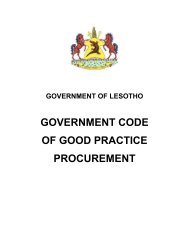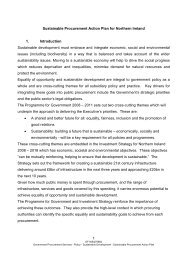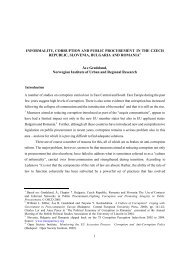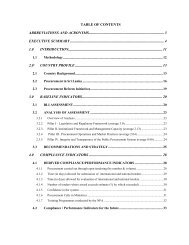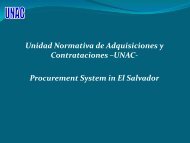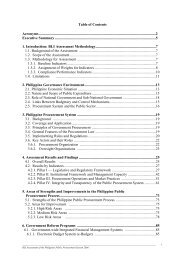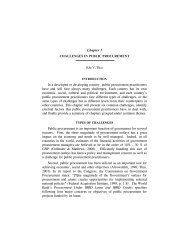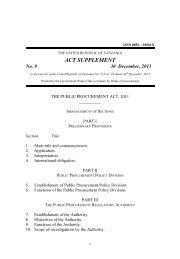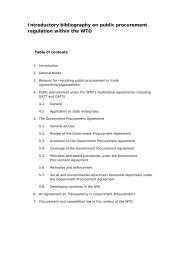Conference Paper: Competitive Dialogue and Negotiated Procedure ...
Conference Paper: Competitive Dialogue and Negotiated Procedure ...
Conference Paper: Competitive Dialogue and Negotiated Procedure ...
Create successful ePaper yourself
Turn your PDF publications into a flip-book with our unique Google optimized e-Paper software.
3rd public procurement Ph.D. conference Nottingham University<strong>Conference</strong> <strong>Paper</strong>: <strong>Competitive</strong> <strong>Dialogue</strong> <strong>and</strong> <strong>Negotiated</strong> <strong>Procedure</strong> in thePublic Sector Directive 2004/18/ECTable of Contentsby Ruth Losch, Universität Heidelberg, GermanyI. Introduction.........................................................................................................................1II. Overview of procurement procedures ...............................................................................1III. The pre-requisites of entering into a competitive dialogue or a negotiated procedure....21. Pre-requisites for negotiated procedures which do not refer to the content of thecontract...............................................................................................................................32. Content-related justifications for the negotiated procedure ...........................................3a. Complexity <strong>and</strong> “no specifications” ground ..............................................................3aa. Technical complexity <strong>and</strong> “no specifications” ground.........................................4(1.) Art. 23 (3) <strong>and</strong> the negotiated procedure.........................................................5(2.) The contracting authority’s discretion in identifying the complexity of thecontract...................................................................................................................6bb. Legal/financial complexity <strong>and</strong> “no specifications” ground................................8b. Complexity <strong>and</strong> “no overall pricing” ground.............................................................9aa. Technical complexity <strong>and</strong> “no overall pricing” ground .......................................9bb. Legal/financial complexity <strong>and</strong> “no overall pricing” ground ..............................93. Conclusion on entry pre-requisites.................................................................................9IV. Procedural aspects of the competitive dialogue <strong>and</strong> the negotiated procedure .............101. Discussion phase ..........................................................................................................10a. Basic structure of discussion....................................................................................10b. Scope of tenders.......................................................................................................11aa. <strong>Negotiated</strong> procedure..........................................................................................11bb. <strong>Competitive</strong> dialogue .........................................................................................12(1) Needs ..............................................................................................................12(2) Requirements..................................................................................................12cc. Conclusion on scope...........................................................................................132. Assessing tenders .........................................................................................................143. Conclusion on procedural aspects................................................................................16V. Final conclusions.............................................................................................................16
I. IntroductionThe Public Sector Directive 2004/18/EC introduces a new procurement procedure, thecompetitive dialogue. As the competitive dialogue aims to provide a flexible approach tothe award of complex contracts, it seems to take a place where formerly mainly the negotiatedprocedure has been in use. In this paper, I would like to take a closer look on the prerequisiteswhich have to be fulfilled to enter these two procedures, in order to assess if, <strong>and</strong>how far, the areas of application overlap. Afterwards, I will briefly consider the basis <strong>and</strong>the scope of discussions that are allowed when using the competitive dialogue respectivelynegotiated procedure to show the consequences of choosing one or the other procedurewhen having the choice to do so.II. Overview of procurement proceduresThe Public Sector Directive offers the open <strong>and</strong> the restricted procedure as st<strong>and</strong>ardprocedures, Art. 28. 1 Presupposing the suitability of the tenderers both procedures followthe following pattern:drawing up tender specifications|public notice|submission of tenders|assessing tenders|award of contractThe negotiated procedure follows the same pattern, only that instead of mere assessing oftenders by the procuring entity, it engages in negotiations with the tenderers concerningtheir initial offers.In competitive dialogue, the basic structure changes. Whereas open, restricted <strong>and</strong>negotiated procedure require the drawing up of tender specifications, on which groundsoffers by the tenderers are made, the competitive dialogue allows “tender specifications” tobe more than unspecific in some points; furthermore, it suffices to provide a “descriptivedocument” lining out the needs <strong>and</strong> requirements of the entity, on which grounds adialogue between the entity <strong>and</strong> each chosen c<strong>and</strong>idate will take place on which solutionsmight meet the needs of the entity.It is only when the dialogue has come to a point that the entity considers its needs to bemet by a solution worked out in the dialogue, that it then asks the c<strong>and</strong>idates to submittheir tenders. These tenders have to contain all the elements required <strong>and</strong> necessary for theperformance of the project. 21 All Articles without further citation refer to the Public Sector Directive 2004/18/EC.2 Art. 29 (3).1
<strong>Competitive</strong> dialoguedescriptive document of needs|publication of notice|dialogue on possible solutions|submission of tenders|assessment of tenders|award of contract<strong>Negotiated</strong> proceduredefining needs (pre-tender)|contract specifications|publication of notice|submission of tenders|negotiating tenders|award of contractOpen/restricted proceduredefining needs (pre-tender)|contract specifications|publication of notice|submission of tenders|assessment of tenders|award of contractSystematically, the main interaction between procuring entity <strong>and</strong> economic operatorduring competitive dialogue takes place in a much earlier stage than in the “classicalprocedures”, i.e. to say before the scope of the tender has become quite clear.III. The pre-requisites of entering into a competitive dialogue or a negotiatedprocedureThe competitive dialogue requires a “particularly complex” contract, where the contractingauthority considers that the use of the open or restricted procedure will not allow the awardof the contract (as at Art. 29 (1)).Art. 1 (11) (c) defines a contract as “particularly complex” when the contractingauthorities:- are not objectively able to define the technical means in accordance with Art. 23(3) (b), (c) or (d), capable of satisfying their needs <strong>and</strong> objectives (technicalcomplexity) <strong>and</strong>/or- are not objectively able to specify the legal <strong>and</strong>/or financial make-up of a project(legal/financial complexity).Both these requirements connect with the needs <strong>and</strong> objectives of the procuring entity, <strong>and</strong>,therefore, with the content of the contract to arrive at as they refer to the nature of theunderlying works, services or supplies, or its legal <strong>and</strong> financial clauses. It, therefore, isdeemed useful to distinguish between pre-requisites for the negotiated procedure that arebased on the content of the procurement <strong>and</strong> those that are not.2
1. Pre-requisites for negotiated procedures which do not refer to the content of thecontractArt. 30 (1) (a) allows the use of the negotiated procedure with a notice in the case of afailure of an open or restricted procedure or a competitive dialogue caused by irregulartenders or the submission of tenders which are unacceptable under national provisions.This is a formal pre-requisite, which does not implicate anything concerning the content ofthe procurement, meaning that the only importance in regard to competitive dialogue isthat the procedure has reached the stage of submitting tenders by the economic operatorsafter concluding the dialogue phase. Its relationship towards the competitive dialog istherefore one of a mere timely order.Art. 30 (1) (d) also does not, in principle, conflict with the competitive dialogue whenadmitting the negotiated procedure with a notice in respect of public works contracts forworks which are performed solely for purposes of research, testing or development <strong>and</strong> notwith the aim of ensuring profitability or recovering research <strong>and</strong> development costs. Theseaims do not touch the content of the contract, but only the purposes the completed workswill serve.Basically, the same as for Art. 30 (1) (a) <strong>and</strong> (d) holds for the requirements, which have tobe met when the entity plans to engage in a negotiated procedure without a notice, Art. 31.The pre-requisites of this article refer to circumstances, which render it highly unlikely thatthe contracting authorities will face a “particularly complex” contract as presupposed forthe competitive dialogue so that no conflicts between the competitive dialogue <strong>and</strong> thenegotiated procedure without a notice 3 are to be expected.2. Content-related justifications for the negotiated procedureUnlike those pre-requisites for the negotiated procedure as just lined out in III 1. the provisions(b) <strong>and</strong> (c) of Art. 30 (1) regarding the negotiated procedure with a notice, i.e. the socalled“no overall pricing” <strong>and</strong> the “no specifications” ground, aim towards the content ofthe procurement, as does the requirement of a particular complex contract in theregulations on the competitive dialogue. It can be expected that it be in these cases, inwhich the question of which procedure in a given case is the “right” procedure becomesmost virulent.a. Complexity <strong>and</strong> “no specifications” groundArt. 30 Nr. 1 (c) holds the negotiated procedure with a notice to be applicable if the natureof services to be providedis such that contract specifications cannot be established with sufficient precision to permitthe award of the contract by selection of the best tender according to the rules governingopen or restricted procedures.3 – which is a highly exceptional procedure anyway <strong>and</strong> which up to now has not been able to find theconsent of the ECJ whenever brought before it. See only ECJ C-24/91 (Commission/Spain), C-84/03(Commission/Italy), C-126/03 (Commission/Germany).3
Beforeh<strong>and</strong>, it should be noted that this provision only refers to services, but not to worksor supplies. 4 Especially in the case of “intellectual services” (as also pointed out by thepublic sector directive) the procuring authority might not be able to describe more than theoutlines of the envisaged project <strong>and</strong> having to rely on the input of the tenderers on what indetail is possible.aa. Technical complexity <strong>and</strong> “no specifications” groundAccording to Art. 1 (11) (c) Public Sector Directive a contract is considered to be “particularlycomplex”, if the contracting authorities- are not objectively able to define the technical means in accordance with Art. 23 (3)(b), (c) or (d), capable of satisfying their needs or objectives.Art. 23 (3) (b) allows to formulate technical specificationsin terms of performance or functional requirements, […]. However, such parameters mustbe sufficiently precise to allow tenderers to determine the subject matter of the contract<strong>and</strong> to allow contracting authorities to award the contract.As the Art. 23 (3) (c) <strong>and</strong> (d) presuppose the possibility to refer to st<strong>and</strong>ardized technicalspecifications in the sense of Art. 23 (3) (a) <strong>and</strong> are therefore stricter than the beforequoted (b) I will only examine this broader provision in more detail.With regard to the competitive dialogue this means that it applies when the authoritycannot draw up the parameters of the contract in a sufficiently precise manner in order toallow tenderers to determine the subject matter of the contract <strong>and</strong>/or contractingauthorities the award of the contract. Commonly, two types of technical complexity arebeing distinguished: one being that the contracting authority does not feel it can determinehow its needs can be fulfilled at all, the other that the authority cannot decide between twoor more possible options to solve its problem. However, when the procuring authority isnot able to think of a possible solution at all, it would be very surprising, if it was notoffered different possibilities to solve this problem, so it is in both cases the maincharacteristic of the competitive dialogue that it points to a range of possible outcomes.If the competitive dialogue shall only be applicable, if not even Art. 23 (3) (b) can befulfilled, two points become crucial to the relationship between negotiated procedure <strong>and</strong>competitive dialogue based on technical complexity:1. Does art. 23 (3) fully apply to negotiated procedures?If negotiated procedures do not have to follow suit to Art. 23 (3) it can be concluded thatthere are serious overlaps between the two procedures when based on the “no4 But as Art. 30 Nr. 1 (c) does not speak of service contracts but merely of services it can not be excludedthat the negotiated procedure with a notice is to be made accessible if a works or supplies contract containsservice elements that fall under this provision; Arrowsmith, The Law of Public <strong>and</strong> Utilities Procurement, 2 nded. 2005, para 8.14.4
specifications” ground resp. technical complexity. If, on the other h<strong>and</strong>, Art. 23 (3) has tobe complied to in the case of all negotiated procedure there might still be room foroverlaps, depending on how free the procuring authority is in determining whether it isable to comply with Art. 23 (3), or if it faces a particularly complex contract, which leadsto the question:2. Does the procuring authority have any discretionary power in deciding whether itcan meet the criteria lined out in Art. 23 (3)?(1.) Art. 23 (3) <strong>and</strong> the negotiated procedureIt is out of question that, if an entity intends to use an open or restricted procedure, it has tofollow suit to Art. 23 (3). However, it is uncertain if this provision also has to be met whenthe entity plans to use the negotiated procedure. 5Against the application of Art. 23 (3) to negotiated procedures holds that Art. 29 (1) forthe applicability of the competitive dialogue does not mention the negotiated procedure,but only refers to open <strong>and</strong> restricted procedure, which in the given case would not allowthe award of a particularly contract. This could lead to the conclusion e contrario that infact there are particularly complex contracts not following Art. 23 (3), which can beawarded using – though not the open or restricted – the negotiated procedure. 6Another argument can be drawn from the wording of Art. 23 (3) regarding “technical”specifications, whereas the rules governing the negotiated procedure merely speak of“specifications” or “contract specifications”.An argument in favour of the application of Art. 23 (3) to negotiated procedures is thatthere is no indication why the need to draw up technical specifications in form ofperformance or functional requirements should not be a general rule. This is supported byconsideration 29 Public Sector Directive:The technical specifications drawn up by public purchasers need to allow publicprocurement to be opened up to competition. […]Also, Art. 1 (11) (c) explicitly exempts technical complex contracts from Art. 23 (3), butnone of that is provided for cases, in which the negotiated procedure can be used. The reasonthat Art. 30 (1) (c) does not speak of “technical specifications”, but of “specifications”in general might as well simply point to the fact that not all specifications of a contract areof a technical character. Annex VI (1) (b) Public Sector Directive states that “technicalspecifications” define the required characteristics of a service. Finally, Art. 30 (1) (c) doesnot hold that contract specifications cannot be drawn up at all, but that it must not be5 Arrowsmith, (fn. 4), para 17.68.6Also states consideration 31:To the extent that the use of open or restricted procedures does not allow the award of suchcontracts a flexible procedure should be provided which preserves […] the need for the contractingauthorities to discuss all aspects of the contract with each c<strong>and</strong>idate.5
possible to establish the specifications with sufficient precision to allow the award of thecontract using the open or restricted procedure.Constraining the use of the negotiated procedure to Art. 23 (3) would not render thisprocedure unpractical or too narrow. There are no grounds on which one could assume thatcontract specifications used in a negotiated procedure have to be as detailed as in an openor restricted procedure, esp. as Art. 30 (1) (c) only states that they cannot be drawn up asfor an open or restricted procedure, which does not entail that specifications cannot bedrawn up at all. However, this underst<strong>and</strong>ing would still rule out an inaccuracy of the basicfeature of the tender, so that if choosing the negotiated procedure the authority wouldexplicitly have to admit variants in the sense of Art. 24, which would include statingminimum <strong>and</strong> specific requirements, Art. 24 (2).(2.) The contracting authority’s discretion in identifying the complexity of the contractWhen following the point of view that Art. 23 (3) applies to negotiated procedures therestill might be some room for factual overlaps with technical complex contracts, dependingon how strict the objectivity of a complex contract is defined in a single case.Art. 29 (1) states that in the case of a particularly complex contract where contractingauthoritiesconsider that the use of open or restricted procedure will not allow the award of the contract,[…][they] may make use of the competitive dialogue.The words consider <strong>and</strong> may indicate a certain degree of discretionary power. On the otherh<strong>and</strong>, Art. 1 (11) (c) states that contracting authorities “must not be objectively able” todefine the technical means to fulfil their needs. This wording hardly leaves room for theauthority to consider whether it can use the open or restricted procedure, or not. It has beenrightly pointed out that, if this objective inability was read in a too strict sense, this wouldlead to no-one being able to draw up technical specifications, i.e. no economic operatoreither <strong>and</strong> leave no possible use for the competitive dialogue. 7On the other h<strong>and</strong>, Art. 36 <strong>and</strong> Annex VII A Public Sector Directive hold that theprocuring entity is obliged to define <strong>and</strong> publish its needs as specific as possible. Or withthe words of the ECJ:That obligation of transparency which is imposed on the contracting authority consists inensuring, for the benefit of any potential tenderer, a degree of advertising sufficient toenable the […] market to be opened up to competition <strong>and</strong> the impartiality of procurementprocedures. 8Having to find a balance between the practical need for flexibility <strong>and</strong> the aim of equaltreatment <strong>and</strong> transparency, this leads to the assumption that the procuring authority cannot7 Alex<strong>and</strong>er Kus, Die richtige Verfahrensart bei PPP-Modellen, insbesondere Verh<strong>and</strong>lungsverfahren undwettbewerblicher Dialog, Vergaberecht 2006, p 858.8 ECJ, C-470/99 (Universale Bau), para 93.6
at its free discretion choose the competitive dialogue, whenever it fears the work ofdeveloping the contract specifications itself, but has to be able to justify its assumption thata contract is particularly complex. 9 Also, the grounds for deciding on this must fully st<strong>and</strong>up to a review before a judge. 10 The same holds for the decision whether in a given casethe “no specification” ground justifying the use of the negotiated procedure can be applied.It has been discussed whether the procuring authority has to engage in a “technicaldialogue” (consideration 8 Public Sector Directive) with an economic operator in order toestablish contract specifications. 11 However, by doing so, the authority risks to lose onepossible tenderer. Allowing the economic operator to take part in the award procedurewould often indicate a threat to equal treatment <strong>and</strong> competition, because it is hard toexclude that the economic operator adjusts the contract specifications to its own strengths<strong>and</strong> economic situation. 12 But in situations, where only few economic operators are atdisposal at all, losing a potential bidder can lead to restriction of competition as well. Asthe competitive dialogue was designed to avoid this problem, 13 it follows that at least inprocurements where there are few suitable economic operators, the procuring authorityshould not be obliged engage in a technical dialogue. However, the procuring authoritywill have to be able to prove serious efforts on its behalf in determining the contractspecifications.It also has to be born in mind that even though it might not be in the procuring authority’sdiscretion to decide whether a contract is particularly complex or the “no specifications”ground applies, it is in the authorities discretion to decide what its needs are. Or as aGerman court put it:To exaggerate, one might say that if a procuring authority ordered golden tabs for trainlavatories, this would in all probability be a case for the supervisory board or the AuditOffice. From a public procurement point of view this would not be a problem, becausesolely the procuring authority decides what it wants <strong>and</strong> how it wants it. 14If it is in the authority’s discretion to decide what it wants, this leads to the resumption thatthe contracting authority can influence the procedure it wants to use by deciding on itsneeds. If an entity wants to use the negotiated procedure, it has to be able to draw upcontract specifications that st<strong>and</strong> up to Art. 23 (3), if need be, by restricting its dem<strong>and</strong>s.Otherwise, it has to use the competitive dialogue or organise a design contest.9 Hans-Joachim Prieß, H<strong>and</strong>buch des europäischen Vergaberechts, 3 rd ed. 2005, p. 202 with further reference.10 Hermann Pünder / Ingo Franzius, Auftragsvergabe im wettbewerblichen Dialog, ZfBR 2006, p. 20.11 Matthias Knauff, Im wettbewerblichen Dialog zur Public Private Partnership?, NZBau 2005, p. 253 withfurther reference.12 Steen Treumer, Technical dialogue <strong>and</strong> the principle of equal treatment, P.P.L.R. 2007, p. 99 ff.13 Elke Bischof / Jörg Stoye, Vergaberechtliche Neuerungen für IT/TK-Beschaffungen der öffentlichen H<strong>and</strong>– Das ÖPP-Beschleunigungsgesetz als erste Umsetzung des EU-Richtlinienpakets, MMR 2006, p. 143.14OLG Koblenz (German Higher Regional Court), Decision of 5. 9. 2002 - 1 Verg 2/02:Überspitzt ausgedrückt: Verlangt ein Aufgabenträger die Ausstattung der Zugtoiletten mit goldenenArmaturen, so ist das mit hoher Wahrscheinlichkeit ein Fall für Aufsichtsbehörde oder Rechnungshof.Vergaberechtlich wäre dagegen nichts einzuwenden, weil allein der Auftraggeber entscheidet,was er haben will und wie er es haben will.7
In the end it has to be kept in mind that the question, whether an intended project cannot bespecified to meet the requirements of Art. 23 (3), will always be a decision of degree,which will have to be formed out by the contracting authorities <strong>and</strong> approved by the courtsin particular cases. 15 As German courts are considering the negotiated procedure as anexceptional one in general, they will more likely restrict the scope of the negotiatedprocedure with a notice - which is also backed up by the comparatively strict Germansystem, in which even the restricted procedure is deemed exceptional in relation to theopen procedure. The Public Sector Directive leaves room for both possibilities, although inmy opinion the need for equal treatment <strong>and</strong> transparency as lined out by the ECJ holdagainst a too broad conception of the entering pre-requisites of the negotiated procedure.bb. Legal/financial complexity <strong>and</strong> “no specifications” groundNext to technical complexity the use of the competitive dialogue can be established onlegal/financial complexity. According to Art. 1 (11) (c) a contract is considered to be “particularlycomplex” where the contracting authorities– are not objectively able to specify the legal <strong>and</strong>/or financial make-up of a project.The Public Sector Directive offers no further explanations on this point. During thedrafting procedure of the directive, legal <strong>and</strong> financial complexity was mainly linked toprivatisations falling under the public procurement regime, 16 where in fact numerous legal<strong>and</strong> financial facts have to be considered deriving from special legal provisions <strong>and</strong>circumstances as public finances, the wish of remaining influence of the public sector orthe distribution of contract risks. The competitive dialogue may be used in these caseswhen ways of privatisation are at h<strong>and</strong> which are so different that without participation ofspecialized economic operators no reliable statement on the best solution could be made. 17The financial complexity may in many cases come together with technical complexity. Forthe use of competitive dialogue it suffices as a single reason though, so that in this lattercase the technical specifications of the project might well be definable in the sense of Art.23 (3). In relation to the “no specifications” ground for the use of the negotiated procedurethen follows that both procedures are open to the contracting authority.One could argue that it was contradictory to allow a broad variation of legal/financialconstructions, but not a broad approach to the definition of technical specifications as anentry pre-requisite for the negotiated procedure. But for one thing, Art. 1 (11) (c) does inthis respect not refer to a norm like Art. 23 (3). Additionally, legal <strong>and</strong> financial make-upis more unlikely to influence the comparability of the tenders as it is easier assessable inmoney terms.15 See also Steen Treumer, The field of application of competitive dialogue, P.P.L.R. 2006, p. 312.16 See in detail, Pünder / Franzius (fn. 7), fn. 19.17 However, the procedure is inapplicable, as far as the procuring authority knows the framework fromformer, alike privatisations.8
. Complexity <strong>and</strong> “no overall pricing” groundArt. 30 (1) (b) allows the use of the negotiated procedure with a notice inexceptional cases, when the nature of the works, supplies or services or the risks attachedthereto do not permit overall pricing; (“no overall pricing ground”);Following Arrowsmith, the appropriate interpretation of overall pricing is that it refers towhether it is possible to establish a single pricing structure. This might be the case whenfacing unpredictable geological conditions or uncertainty of user dem<strong>and</strong> so thatnegotiations become necessary to evaluate the bidders’ readiness to accept risks or theneed of introducing a “cost-plus” pricing which will shift the risk to the procuring entity. 18The “no overall pricing” ground is in many cases not clearly distinguishable from the “nospecifications” ground, as the difficulty of setting up technical specifications will oftenlead to difficulties to set up a pricing structure. As a result the “no overall pricing” groundcan – concerning works <strong>and</strong> supplies – cover up a little in respect to the non-applicabilityof the “no specifications” ground on works <strong>and</strong> supplies.aa. Technical complexity <strong>and</strong> “no overall pricing” groundIf at the same time a project is technically complex <strong>and</strong> the “no overall pricing” ground canbe applied the procuring entity might be able to reduce the technical complexity bydeciding on a pattern of specifications that accord to Art. 23 (3) <strong>and</strong> then choose thenegotiated procedure. If this is not possible or desirable though, it will have to enter thecompetitive dialogue procedure being the procedure allowing a broader scope ofdiscussions.bb. Legal/financial complexity <strong>and</strong> “no overall pricing” groundWhereas the collision of legal/financial complexity <strong>and</strong> the “no specifications” ground notnecessarily relate to the same side of the contract it seems hard to imagine cases whereuncertainty about the legal or financial make-up of a project as needed for the competitivedialogue would not at the same time lead to the “no overall pricing” ground which justifiesthe use of the negotiated procedure <strong>and</strong> vice versa. In this situation the applicability of thecompetitive dialogue does not exclude the applicability of the negotiated procedure. 193. Conclusion on entry pre-requisitesAfter looking at the pre-requisites of the competitive dialogue <strong>and</strong> the negotiated procedureone can conclude that, when a contract is particularly complex due to technical complexity,18 Arrowsmith, (fn. 4), para 8.9 <strong>and</strong> ff.19 Otherwise European Commission, Green <strong>Paper</strong> on PPP, COM (2004) 327, para 24:The derogation under Article 7 (2) of Directive 93/37/EEC, which provides for recourse to negotiatedprocedure in the case of a contract when “the nature of the works or the risks attaching theretodo not permit prior overall pricing” is of limited scope. This derogation is to cover solely the exceptionalsituations in which there is uncertainty a priori regarding the nature or scope of the work tobe carried out, but is not to cover situations in which the uncertainties result from other causes,such as the difficulty of prior pricing owing to the complexity of the legal <strong>and</strong> financial package putin place.9
the competitive dialogue is the only admissible procedure. However, this is rather not aquestion of priority but one of alternative scenarios. In the case of particularly complexcontracts based only on legal/financial complexity generally both procedures are open tothe choice of the procuring authority. The decision of the procuring authority of whichprocedure to choose will depend on which best meets its needs regarding form <strong>and</strong> scopein a given case.IV. Procedural aspects of the competitive dialogue <strong>and</strong> the negotiated procedureFor the purpose of this speech I will restrict my considerations on the procedure to thescope <strong>and</strong> place of discussion being held with invited <strong>and</strong> therefore suitable procuringentities, which are allowed in the two procedures. I will therefore set aside more detailedquestions concerning the different procedural steps. 201. Discussion phaseI will not talk of rules structuring the discussion phase (as e.g. introducing differentrounds) – I assume that here the jurisdiction concerning equal treatment of tenderers in thenegotiated procedure will in most of the cases apply to the participants of the competitivedialogue also.a. Basic structure of discussionDespite some similarities in the general pattern negotiated procedure <strong>and</strong> competitive dialoguehave different starting points. Whereas negotiations in the negotiated procedure areheld on the basis of initial tenders there is no such formal starting point in the competitivedialogue.As a result, initial tenders in the negotiated procedure have to hold up against the contractspecifications as they would in a open or restricted procedure, i.e. they have to be completewith all requested documents, <strong>and</strong> – though in the somewhat broader scope of negotiatedprocedure contract specifications – all information necessary for concluding the contract asprice, performance <strong>and</strong> place of performance. 21 Tenders that do not live up to these criteriacannot be completed but have to be excluded, as well as tenderers whose tenders failed tomeet the contract specifications. 2220 However, it should be born in mind that a lot of rules that have been developed for the negotiated procedurecan be used for the competitive dialogue as well, e.g. the regulations concerning equal treatment of thetenderers as here procedural equality is concerned. Also, both forms of discussion can be held in phases inwhich at the end there have to be at least two c<strong>and</strong>idates left (Art. 44 (4)), so that discussions with only onepreferred bidder/c<strong>and</strong>idate are no longer possible.21 Jan Byok, Das Verh<strong>and</strong>lungsverfahren, 2006, p. 105.22 EC, T-40/01, Scan Office Design, Slg. 2002, II-5043; BGH (German Federal High Court of Justice), X ZR115/04 of 1.8.2006, both stating that when in the negotiated procedure the contracting authority voluntarilyincludes requirements in the tender specifications these hold valid during the procedure because it cannot beexcluded that bidders did not refrain from taking part in the procedure. Also, Arrowsmith, (fn. 4), para 7.158.10
The competitive dialogue on the other h<strong>and</strong> is not based on binding tenders but onproposals on how possibly the needs of the procuring authority could be met. There is nolegal constraint of excluding c<strong>and</strong>idates from the dialogue because they did not h<strong>and</strong> infully worked out offers or because the proposals did not meet the needs <strong>and</strong> requirementsset out in the contract notice. 23Another consequence of submitting tenders in the negotiated procedure is that each newtender renders the former one void whereas in the competitive dialogue there is no offerwhich can be taken back or be binding in the dialogue phase. Also, it is not impossible –<strong>and</strong> in fact that was one of the ideas the competitive dialogue started from – that during thedialogue the c<strong>and</strong>idates will as a team develop the solutions. However, it is hard to imaginehow this possibility can be more than a theoretical one. Not only that the c<strong>and</strong>idates willmost probably not be ready to share information, but also it is also difficult to imagine howthis “think-tank” could be organised without seriously distorting competition.b. Scope of tendersaa. <strong>Negotiated</strong> procedureWhen asking what can be discussed, <strong>and</strong> how far discussions can go, Art. 30 (2) holds forthe negotiated procedure thatcontracting authorities shall negotiate with tenderers the tenders in order to adaptthem to the requirements, which they have set out in the contract notice, thespecifications <strong>and</strong> additional documents, if any.In this framework set out by the documents mentioned in Art. 30 (2) the single tenders canbe substantially changed. 24 As concerns negotiating the framework, the possibility ofchanges after selecting the tenderers will mainly depend on whether the changes are likelyto change the identity of the participants 25 <strong>and</strong>/or whether they are likely to distortcompetition between the chosen participants. While it is admissible to render the tenderdocuments more specific on some points 26 it can already be questionable if it is allowed toab<strong>and</strong>on parts of the procurement 27 <strong>and</strong> even more difficult to add or change parts of it. Ithas been proposed to draw a border-line where changes in the specifications would involvechanges of the award criteria. 28 However, it would be inconsistent if the rule of Art. 23 (3)could be avoided by allowing changes to the tender documents that led to a broader scopeof tenders in the negotiated procedure.23 This does not mean that the procuring authority may not exclude participants from further rounds in thedialogue, because they failed to meet indicated requirements.24 Answer of the Commission to written question E-2798/02 by MEP Lucas.25 Arrowsmith, (fn. 4), para 7.158.26 Eva-Dorothee Ebert, Möglichkeiten und Grenzen im Verh<strong>and</strong>lungsverfahren, 2005, p. 152.27 VK Bund (German Federal Chamber of Public Procurement), decision of 11.03.2004 – VK 1-151/03.28 Ebert, (fn. 26), p. 154.11
The scope of discussion therefore limits itself to the scope the contract specifications allow(which, as referred to above, have to accord to Art. 23 (3)). If the contracting authoritywanted to go beyond these requirements it would have to allow variants (Art. 24) whichwould then include setting up minimum <strong>and</strong> specific criteria for each point where itexpected differing proposals from the tenderers.bb. <strong>Competitive</strong> dialogueWhile in negotiated procedures the scope of discussions is limited by the tenderspecifications it is “needs <strong>and</strong> requirements”, which are published when using thecompetitive dialogue. 29According to Art. 29 (3) contracting authoritiesshall open […] a dialogue the aim of which shall be to identify <strong>and</strong> define the means bestsuited to satisfying their needs. They may discuss all aspects of the contract with the chosenc<strong>and</strong>idates during this dialogue.(1) NeedsIn competitive dialogue the procuring authority should not need to change its alreadybroadly defined needs if thoroughly prepared. If, however, for e.g. external reasons itsneeds changed, a relatively high probability can be expected that the waiver of publishing anew notice will distort competition. For not only might changing the needs have changedthe possible set of participants, but it can also harder be excluded that there is no unequaltreatment regarding the participants’ capacities of meeting the authority’s needs.If the main aim is to develop solutions for the procuring authorities needs, it becomesinteresting what happens if these needs can be met best by altering the requirements set outin the contract notice <strong>and</strong> the descriptive document. So, it is important, how“requirements” are to be understood in this context <strong>and</strong> how, if at all, they can be changedduring the procedure.(2) RequirementsWhen looking at the German <strong>and</strong> Danish language version of the Directive, one couldcome to think that “requirements” were to be understood as procedural requirements only,like dialogue phases or submission dates, because according to Art. 29 (5) solutionscapable of meeting the authority’s needs are to be identified, <strong>and</strong> because Art. 29 (6) holdsin these languages that the tenders shall contain all “necessary elements” for theperformance of the project instead of “all elements necessary <strong>and</strong> required” as in mostother languages. 30 The Commission apparently presupposes requirements related to the29 Art. 29 (2).30 At least the English, French, Spanish, Italian, Polish, Dutch <strong>and</strong> Swedish version.12
content of the contract; 31 also does at least the German language allow to read“erforderlich” as “both necessary <strong>and</strong> required”.Also, one could come to think that everything that did not constitute the particularcomplexity of the contract – which in the case of only legal/financial complexity would bethe whole set of technical specifications – would have to be set down as a requirement inthe descriptive document. As a consequence, this would lead to the applicability of Art. 23(3) for legally/ financially complex contracts. If these technical requirements were notallowed to be altered during the dialogue phase the advantage of the competitive dialogue,being that c<strong>and</strong>idates can independently develop solutions, could be rendered more or lessvoid, as sometimes a small change in the authority’s requirements can lead to substantialimprovement in efficiency. If the procuring authority did not think of this possibilitybeforeh<strong>and</strong> <strong>and</strong> allowed variants on this point it might lose considerable advantages.The European Commission is quite vague on this point when stating that substantial oreven fundamental requirements may not be altered unless explicit provision is made forsuch a possibility right from the beginning of the procedure. 32It might therefore be preferable to allow the contracting authority to require only what itconsiders as not dispensable <strong>and</strong> to formulate other requirements in terms of morefunctional needs. 33 Doing this, the economic entity that helped drawing up the descriptivedocument would not so easily be lost as a potential c<strong>and</strong>idate/bidder when changes to therequirements were allowed. Otherwise, it would go too far to underst<strong>and</strong> „requirements“ inthe sense of unalterable contract specifications. On the contrary, it can be seen as thespecific advantage of the competitive dialogue procedure that the dialogue phase is asbroad as the definition of the authority’s need in the descriptive documents allows it to be.cc. Conclusion on scopeThe question of scope of competitive dialogue <strong>and</strong> negotiated procedure is the questionthat will in the end decide about the question whether the competitive dialogue is a new,genuine procedure at all. If there were no differences in possible outcomes becausecontract specifications were to the same degree (not) binding in both procedures it wouldnot have been necessary to introduce the competitive dialogue at all. I therefore come tothe conclusion that a procuring authority might in that case prefer the competitive dialogueover the negotiated procedure when the financial/legal complexity 34 of the contract invokesthe possibility of major differences regarding the technical specifications of the project.31 CC/2005/04_rev_1 of 5.10.2005.32 CC/2005/04_rev_1 of 5.10.2005, p. 4 <strong>and</strong> fn. 14.33 In the case VK 30 / 2006 – L of 11.08.2006, recently decided by the Vergabekammer bei der BezirksregierungDüsseldorf (German regional Chamber of Public Procurement), the contracting authority instead ofrequiring a single database for address files could have formulated the need of as few (maintainable) networklinks as possible, which in fact was the reason, why it decided on the requirement of a single database, notknowing that the number of links was in this case not directly connected with the number of data bases.34 Following my findings in III. that (“unreducable”) technical complexity can only be tackled by using thecompetitive dialogue.13
2. Assessing tendersA consequence of allowing discussions on all aspects of the contract in the competitivedialogue procedure is that the scope of the tenders after the conclusion of the dialoguephase might be very broad.Additionally, when finally assessing the tenders in order to award the contract in the competitivedialogue procedure the procuring authority will for the first time receive a legallybinding tender from the economic operator – whereas the final tenders in negotiatedprocedures will be the result of discussion around concrete tenders.With regard to these uncertainties in the competitive dialogue Art. 29 (6) provides thattenders may be clarified, specified <strong>and</strong> fine-tuned at the request of the contractingauthority. However, such clarification, specification, fine-tuning or additionalinformation may not involve changes to the basic features of the tender or the callfor tender, variations in which are likely to distort competition or have adiscriminatory effect.As these clarifications etc. must not lead to substantial changes to the basic features it hasbeen argued that the scope cannot exceed the request for information, which can be askedfor in an open or restricted procedure. 35 This opinion does not take into account that whenusing the competitive dialogue there are no pre-set contract specifications on whichgrounds tenders are being submitted, 36 so that there is no identical set of documents, plansetc. which has to be submitted by each tenderer. Also, the suitability of tenderers has to bedefined prior to knowing the exact shape of the contract. As a result the suitability cannotbe verified as detailed as in the classical procedures 37 <strong>and</strong> additional documents might beneeded to prove the tenderers suitability for the specific tender. I therefore conclude thatbefore assessing the tenders the procuring authority can at least request such information,which it would have requested if it had set up contract specifications for this concretetender before its submission. However, if a tender has been h<strong>and</strong>ed in that is in such a wayincomplete that additional information had to be requested in order to provide all necessary<strong>and</strong> required 38 elements of an offer this tender would have to rejected as incomplete. 39Furthermore, Art. 29 (7) states that35 Matthias Knauff, Neues europäisches Vergaberecht: Der wettbewerbliche Dialog, Vergaberecht 2004, 294.36 although the French Code des Marchés Publics 2004 which came into force even before the Public SectorDirective provided for the drawing up of tender specifications by the procuring authority with the end of thedialogue. This obligation was abolished with the new Code des Marchés Publics 2006, as it was deemed notonly unpractical but also a threat to the protection of confidential information <strong>and</strong> equal treatment, eventhough the specifications were supposed to be quite broad, presenting only the “core” of the differentpropositions made by the economic operators; www.minefi.fr as on 11.11.2005.37 During the drafting procedure it was discussed whether after the conclusion of the dialogue phase the suitabilityof the c<strong>and</strong>idates/tenderers should be assessed a second time. In the end this was conceived todangerous to risk manipulation in favour of the secretly preferred c<strong>and</strong>idate.38 Art. 29 (6).39 See also Steven Verschuur, <strong>Competitive</strong> <strong>Dialogue</strong> <strong>and</strong> the Scope for Discussion after Tenders <strong>and</strong> BeforeSelecting the Preferred Bidder - What is Fine Tuning, etc.? P.P.L.R. 2006, p. 328.14
at the request of the contracting authority the tenderer having submitted the mosteconomically advantageous tender may be asked to clarify aspects of the tender orconfirm commitments contained in the tender provided this does not have the effectof modifying substantial aspects of the tender or of the call for tender <strong>and</strong> does notrisks distorting competition or causing discrimination.With regard to this provision, it is currently being discussed whether post-tender discussionswith a preferred bidder should be allowed in competitive dialogue. 40 Even thoughthere are (mainly pragmatic) reasons, which may render post-tender negotiations desirable,there are also serious objections against it. For one thing, post-tender negotiations wereexplicitly not implemented in the Public Sector Directive during its drafting. 41The Public Procurement Directive allows to ask all tenderers clarification, specification<strong>and</strong> fine-tuning (Art. 29 (6)). Furthermore, the tenderer having submitted the most economicallyadvantageous tender may be asked for clarification <strong>and</strong> confirming of commitmentscontained in the tender only – specification <strong>and</strong> fine-tuning are no further mentionedin Art. 29 (7). Whereas in the pre-selection phase clarification, specification <strong>and</strong> finetuningmay lead to “additional information”, 42 art. 29 (7) does not assume there be such“additional information”. This wording points towards a smaller scope of interaction withthe tenderer having submitted the most economically advantageous tender compared to thesituation of Art. 29 (6) before ranking the tenders. This opinion is backed up by consideration31 Public Sector Directive:However, this procedure must not be used in such a way as to restrict or distortcompetition, particularly by altering any fundamental aspects of the offers, or byimposing substantial new requirements on the successful tenderer, […]So would negotiating a lower price be a substantial new requirement on the successful tendereras the price is one of the main features of an offer. 43 Finally, allowing substantial negotiationswith a preferred bidder could lead the authority to prematurely conclude thedialogue phase in order to restrict discussions to the preferred c<strong>and</strong>idate/bidder.It has to be born in mind that the scope of discussions during the dialogue phase is verybroad compared to the negotiated procedure. It should be possible to discuss the solutionsduring the dialogue phase until a point where the procuring authority does not expect thatfurther negotiations should give it even more advantages. After determining the mosteconomically advantageous tender interaction with the tenderer should be restricted toassuring that the offer made can be put into practice.40 Ciara Kennedy-Loest, What can be done at the Preferred Bidder Stage in <strong>Competitive</strong> <strong>Dialogue</strong>? P.P.L.R.2006, p. 316-326;41 Rf. Art. 34 Proposition of the EP, protocol of the EP dated 17.1.2002, A5-0378/2001: www.europarl.eu.int.<strong>and</strong> the reaction of the Commission, OCB EG Nr. C 203E dated 27.8.2002, p. 214.42 Note: the Dutch Version of the Directive does not mention “additional information” but seems to includethis in the term “nauwkeuriger umschrijving” which replaces the English “fine-tuning” but might be bettertranslated with “more exact definition”.43 Kus, (fn. 7), p. 862; in favour of negotiations on price Arrowsmith (fn. 4), para 10.54.15
3. Conclusion on procedural aspectsConcluding, competitive dialogue <strong>and</strong> negotiated procedure prove to be different in scope<strong>and</strong> systematical place of interaction between procuring authority <strong>and</strong> economic operator.Compared to the negotiated procedure the competitive dialogue allows a broader scope ofdiscussion <strong>and</strong> possible outcomes. As these broad variations of tenders submitted in thecompetitive dialogue cannot be assessed on an identical set of contract specifications as inthe negotiated procedure choosing the economically most advantageous tender isconsiderably more difficult than in the negotiated procedure.V. Final conclusionsThe competitive dialogue has been designed not only to provide a new flexible approach tocomplicated public procurements, but also to increase competition, equal treatment <strong>and</strong>transparency. 44 Therefore, I underst<strong>and</strong> the provisions in the public sector directive in away that the competitive dialogue by allowing a wider range of discussion than thenegotiated procedure the “price” for this is a fairly stricter procedural pattern which e.g.limits post tender discussions to aspects that would not lead to more than assuring thetenders can be put into practice.The competitive dialogue may be used when alternative outcomes are expected <strong>and</strong>desired. Most likely this will be the case when the contracting authority’s needs are notonly very complicated or new projects are at stake but also in that case where there are notenough potential economic operators who could provide solutions for the entity’s needs. Inthis case the competitive dialogue allows the contracting authority to access as manyeconomic operators as possible by leaving a margin for different solutions that eacheconomic operator can adjust to its own special economical <strong>and</strong> technical possibilities <strong>and</strong>strengths. Additionally, it will not “lose” enterprises involved in the drawing up of tenderspecifications as potential bidders.When it is not for technical reasons the procuring entity enjoys a wider range of discretionwhether to choose the competitive dialogue or the negotiated procedure. It has to decidewhether it opens “all aspects of the contracts” for discussion but risks ending up with differentcontract specifications <strong>and</strong> therefore harder to compare tenders or if the technicalspecifications as laid down in the contract notice should be met by all tenderers, by whichpossibly missing out on a even better solution but gaining comparability <strong>and</strong> being able tonegotiate on binding offers.44 Consideration 2 Public Sector Directive.16



